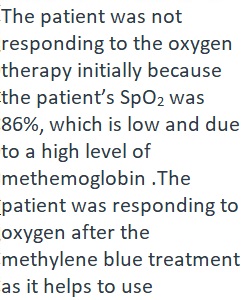


Q Respiratory case: A 68-year-old, non-smoking female presented to the Emergency Room for evaluation of dyspnea (shortness of breath) of 1-hour duration. On examination, her vital signs were: temperature of 98.8°F; pulse of 90 beats/minute; respiratory rate of 20 breaths/ minute; and weight of 140 lbs. In addition, lung sounds were clear (without wheezes or dullness). She indicated that she had been feeling unwell for over three days and that several of her family members had been coughing. She also indicated that she had self medicated on Bactrim™, a sulfonamide antibiotic that her much younger sister had been prescribed. Initial arterial blood gas analysis indicated a pH of 7.50; PO2 of 96 mm Hg; PCO2 of 25 mm Hg; bicarbonate level of 24 mmol/L; and oxygen saturation (SpO2) of 88%. The patient’s labored breathing subsequently worsened. The patient’s pulse oximetry (SpO2) reading worsened to 86% and did not increase after the patient was given oxygen by nasal cannula. A pulse oximetry reading measures oxygen levels in oxygenated blood; a healthy person normally has a value of 98–100%. Blood drawn from the patient’s left arm (from a vein) was chocolate colored. In a healthy individual, such blood is dark red. A second blood sample was drawn from the radial artery. Blood gas analysis revealed a methemoglobin level of 23%, a level that is way above the normal (of about 1%). This is consistent with the original findings and the lack of response to oxygen therapy. Oxygen therapy was continued and methylene blue (1 mg/kg) was co-administered. Pulse oximetry readings indicated that SpO2 improved to approximately 89%. Approximately 5 minutes after the first dose, another 1 mg/k dose of methylene blue was given and the SpO2 improved to 92%. The patient was moved to the ward and, after two uneventful days, was discharged. She was provided with an inhaler containing a bronchodilator and instructed in its use. She was asked to use it in case of onset of renewed shortness of breath. She was cautioned to stop taking additional Bactrim™ and any prescription medication not specifically prescribed for her. She was also asked to follow up with her private physician.
Q 1. Why did the patient not respond to oxygen therapy initially? Why did the patient become responsive to oxygen after the methylene blue treatments?
View Related Questions